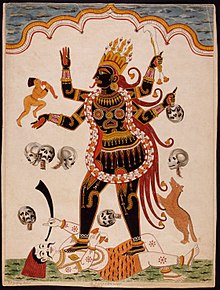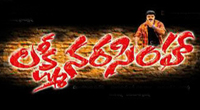| Kali | |
|---|---|
| Goddess of Time, Creation, Destruction and Power | |
 | |
| Affiliation | Mahavidya, Devi, Tridevi, Durga, Parvati, Verama Kali |
| Abode | Cremation grounds (but varies by interpretation) |
| Weapon | Scimitar, Sword, Trishula (Trident) |
| Mount | Lion |
| Festivals | Kali Puja, Navratri |
| Consort | Shiva, Mahakala |
K?l? (/?k??li/; Sanskrit: ????), also known as K?lik? (Sanskrit: ??????), is a Hindu goddess. Kali is one of the ten Mahavidyas, a list which combines Sakta and Buddhist goddesses.
Kali's earliest appearance is that of a destroyer of evil forces. She is the goddess of one of the four subcategories of the Kulam?rga, a category of tantric Saivism. Over time, she has been worshipped by devotional movements and tantric sects variously as the Divine Mother, Mother of the Universe, Adi Shakti, or Adi Parashakti. Shakta Hindu and Tantric sects additionally worship her as the ultimate reality or Brahman. She is also seen as divine protector and the one who bestows moksha, or liberation. Kali is often portrayed standing or dancing on her consort, the Hindu god Shiva, who lies calm and prostrate beneath her. Kali is worshipped by Hindus throughout India.
Contents
Etymology
K?l? is the feminine form of k?lam ("black, dark coloured"). K?l? also shares the meaning of "time" or "the fullness of time" with the masculine noun "k?la"—and by extension, time as "changing aspect of nature that bring things to life or death." Other names include K?lar?tri ("the black night"), and K?lik? ("the black one").
The homonymous k?la, "appointed time," which depending on context can mean "death," is distinct from k?la "black," but became associated through popular etymology. The association is seen in a passage from the Mah?bh?rata, depicting a female figure who carries away the spirits of slain warriors and animals. She is called k?lar?tri (which Thomas Coburn, a historian of Sanskrit Goddess literature, translates as "night of death") and also k?l? (which, as Coburn notes, can be read here either as a proper name or as a description "the black one"). K?l? is also the feminine form of K?la, an epithet of Shiva, and thus the consort of Shiva.
Origins
Hugh Urban notes that although the word K?l? appears as early as the Atharva Veda, the first use of it as a proper name is in the Kathaka Grhya Sutra (19.7). Kali appears in the Mundaka Upanishad (section 1, chapter 2, verse 4) not explicitly as a goddess, but as the black tongue of the seven flickering tongues of Agni, the Hindu god of fire.
According to David Kinsley, K?li is first mentioned in Hindu tradition as a distinct goddess around 600 AD, and these texts "usually place her on the periphery of Hindu society or on the battlefield." She is often regarded as the Shakti of Shiva, and is closely associated with him in various Puranas.
Her most well known appearance on the battlefield is in the sixth century Devi Mahatmyam. The deity of the first chapter of Devi Mahatmyam is Mahakali, who appears from the body of sleeping Vishnu as goddess Yoga Nidra to wake him up in order to protect Brahma and the World from two demons Madhu and Kaitabha. When Vishnu woke up he started a war against the two demons. After a long battle with lord Vishnu when the two demons were undefeated Mahakali took the form of Mahamaya to enchant the two asuras. When Madhu and Kaitabha were enchanted by Mahakali, Vishnu killed them.
In later chapters the story of two demons can be found who were destroyed by Kali. Chanda and Munda attack the goddess Durga. Durga responds with such anger that her face turns dark and Kali appears out of her forehead. Kali's appearance is black, gaunt with sunken eyes, and wearing a tiger skin and a garland of human heads. She immediately defeats the two demons. Later in the same battle, the demon Raktabija is undefeated because of his ability to reproduce himself from every drop of his blood that reaches the ground. Countless Raktabija clones appear on the battlefield. Kali eventually defeats him by sucking his blood before it can reach the ground, and eating the numerous clones. Kinsley writes that Kali represents "Durga's personified wrath, her embodied fury."
Other origin stories involve Parvati and Shiva. Parvati is typically portrayed as a benign and friendly goddess. The Linga Purana describes Shiva asking Parvati to defeat the demon Daruka, who received a boon that would only allow a female to kill him. Parvati merges with Shiva's body, reappearing as Kali to defeat Daruka and his armies. Her bloodlust gets out of control, only calming when Shiva intervenes. The Vamana Purana has a different version of Kali's relationship with Parvati. When Shiva addresses Parvati as Kali, "the black one," she is greatly offended. Parvati performs austerities to lose her dark complexion and becomes Gauri, the golden one. Her dark sheath becomes Kausiki, who while enraged, creates Kali. Regarding the relationship between Kali, Parvati, and Shiva, Kinsley writes that:
In relation to Siva, she appears to play the opposite role from that of Parvati. Parvati calms Siva, counterbalancing his antisocial or destructive tendencies; she brings him within the sphere of domesticity and with her soft glances urges him to moderate the destructive aspects of his tandava dance. Kali is Shiva's "other wife," as it were, provoking him and encouraging him in his mad, antisocial, disruptive habits. It is never Kali who tames Siva, but Siva who must calm Kali.
Legends
K?li appears in the Sauptika Parvan of the Mahabharata (10.8.64). She is called K?lar?tri (literally, "black night") and appears to the Pandava soldiers in dreams, until finally she appears amidst the fighting during an attack by Drona's son Ashwatthama.
Another story involving Kali is her escapade with a band of thieves. The thieves wanted to make a human sacrifice to Kali, and unwisely chose a saintly Brahmin monk as their victim. The radiance of the young monk was so much that it burned the image of Kali, who took living form and killed the entire band of thieves, decapitating them and drinking their blood.
Slayer of Raktabija
In K?li's most famous legend, Durga and her assistants, the Matrikas, wound the demon Raktabija, in various ways and with a variety of weapons in an attempt to destroy him. They soon find that they have worsened the situation for with every drop of blood that is dripped from Raktabija he reproduces a clone of himself. The battlefield becomes increasingly filled with his duplicates. Durga summons K?li to combat the demons. The Devi Mahatmyam describes:
Out of the surface of her (Durga's) forehead, fierce with frown, issued suddenly Kali of terrible countenance, armed with a sword and noose. Bearing the strange khatvanga (skull-topped staff ), decorated with a garland of skulls, clad in a tiger's skin, very appalling owing to her emaciated flesh, with gaping mouth, fearful with her tongue lolling out, having deep reddish eyes, filling the regions of the sky with her roars, falling upon impetuously and slaughtering the great asuras in that army, she devoured those hordes of the foes of the devas.
Kali consumes Raktabija and his duplicates, and dances on the corpses of the slain. In the Devi Mahatmya version of this story, Kali is also described as a Matrika and as a Shakti or power of Devi. She is given the epithet C??u??? (Chamunda), i.e. the slayer of the demons Chanda and Munda. Chamunda is very often identified with Kali and is very much like her in appearance and habit.
Iconography and forms
Kali is portrayed mostly in two forms: the popular four-armed form and the ten-armed Mahakali form. In both of her forms, she is described as being black in colour but is most often depicted as blue in popular Indian art. Her eyes are described as red with intoxication, and in absolute rage, her hair is shown disheveled, small fangs sometimes protrude out of her mouth, and her tongue is lolling. She is often shown naked or just wearing a skirt made of human arms and a garland of human heads. She is also accompanied by serpents and a jackal while standing on the calm and prostrate Shiva, usually right foot forward to symbolize the more popular Dakshinamarga or right-handed path, as opposed to the more infamous and transgressive Vamamarga or left-handed path.
In the ten-armed form of Mahakali she is depicted as shining like a blue stone. She has ten faces, ten feet, and three eyes for each head. She has ornaments decked on all her limbs. There is no association with Shiva.
The Kalika Purana describes Kali as possessing a soothing dark complexion, as perfectly beautiful, riding a lion, four-armed, holding a sword and blue lotuses, her hair unrestrained, body firm and youthful.
In spite of her seemingly terrible form, Kali Ma is often considered the kindest and most loving of all the Hindu goddesses, as she is regarded by her devotees as the Mother of the whole Universe. And because of her terrible form, she is also often seen as a great protector.
When the Bengali saint Ramakrishna once asked a devotee why one would prefer to worship Mother over him, this devotee rhetorically replied, "Maharaj, when they are in trouble your devotees come running to you. But, where do you run when you are in trouble?"
Popular form
Classic depictions of Kali share several features, as follows:
Kali's most common four armed iconographic image shows each hand carrying variously a sword, a trishul (trident), a severed head, and a bowl or skull-cup (kapala) catching the blood of the severed head.
Two of these hands (usually the left) are holding a sword and a severed head. The sword signifies divine knowledge and the human head signifies human ego which must be slain by divine knowledge in order to attain moksha. The other two hands (usually the right) are in the abhaya (fearlessness) and varada (blessing) mudras, which means her initiated devotees (or anyone worshipping her with a true heart) will be saved as she will guide them here and in the hereafter.
She has a garland consisting of human heads, variously enumerated at 108 (an auspicious number in Hinduism and the number of countable beads on a japa mala or rosary for repetition of mantras) or 51, which represents Varnamala or the Garland of letters of the Sanskrit alphabet, Devanagari. Hindus believe Sanskrit is a language of dynamism, and each of these letters represents a form of energy, or a form of Kali. Therefore, she is generally seen as the mother of language, and all mantras.
She is often depicted naked which symbolizes her being beyond the covering of Maya since she is pure (nirguna) being-consciousness-bliss and far above prakriti. She is shown as very dark as she is brahman in its supreme unmanifest state. She has no permanent qualities—she will continue to exist even when the universe ends. It is therefore believed that the concepts of color, light, good, bad do not apply to her.
Mahakali
Watch movie Ranchandi online on Amazon
Watch movie Ranchandi online
Watch The Movie On PrimeCash Full HD Movie Download

Kabzaa-The Mafia Raaj Full HD Movie Download

Do Ustaad Full HD Movie Download

Teen Chor Full HD Movie Download

Bhediyon Ke Samooh Full HD Movie Download

Romeo Juliet Full HD Movie Download

Karz Chukana Hai Full HD Movie Download

Black Friday Full HD Movie Download

Chamatkar Full HD Movie Download

Daulat Ki Jung Full HD Movie Download

Udaan Full HD Movie Download

Mohabbat (1997) Full HD Movie Download
.jpg)
Munimji (1955) Full HD Movie Download
.jpg)
Azaad (1978) Full HD Movie Download
.jpg)
We Married Margo Full HD Movie Download

Gunehgar Kaun Full HD Movie Download

Nyayam Meere Cheppali Full HD Movie Download

Vaddante Dabbu Full HD Movie Download

Coyamuthur Maaplaey Full HD Movie Download

Lakshami Narasima Full HD Movie Download

Darithapina Mahnishi Full HD Movie Download

Download latest Movie from bollywood
- 1> baaghi 3
- 2> THE SKY IS PINK MOVIE FULL STORY AND REVIEW
- 3> Luka Chuppi
- 4> TO ALL THE BOYS I’VE LOVED BEFORE
- 5> Kabir Singh
- 6> Street Dancer 3D
- 7> Simmba
- 8> Gone Girl
- 9> The Girl Who Lived
- 10> Ludo
- 11> DILWALE DULHANIA LE JAYENGE
- 12> GUILTY
- 13> The Godfather
- 14> Adventures of Rusty
- 15> Sooryavanshi
- 16> Satyameva Jayate 2
- 17> Thappad
- 18> Bhool Bhulaiyaa 2
- 19> KGFChapter 2
- 20> Mardaani 2
- 21> Pinjar
- 22> Shivaji maharaj
- 23> Ek Villian 2
- 24> Hungama 2
- 25> Divergent
- 26> Mumbai Saga
- 27> The Internship
- 28> HIT (telugu)
- 29> Panga
- 30> The perfect date
- 31> 16 December
- 32> Gopala Gopala (Telugu)
- 33> Brahmastra
- 34> Gangubai Kathiawadi
- 35> Manmadhudu
- 36> Nenu local
- 37> Mahanati
- 38> Shatamanam bavathi
- 39> Lagaan
- 40> After
- 41> MOM
- 42> Shamshera
- 43> Raguvaran BTech
- 44> Khakee
- 45> The villain
- 46> OM
- 47> Mr. perfect
- 48> Bueatifull mind
- 49> Hichki
- 50> Gabbar Singh
- 51> Jogi
- 52> Before Sunrise
- 53> Before Sunset
- 54> Before Midnight
- 55> The Big Bull
- 56> Top Gun: Maverick
- 57> The Purge
- 58> The Sky is Pink
- 59> Laxmmi Bomb
- 60> Sadak 2
- 61> Sufna
- 62> Prithviraj
- 63> PK
- 64> Coolie No 1(2020)
- 65> Black Widow
- 66> Dear Zindagi
- 67> Dil Bechara
- 68> PHIR HERA PHERI
- 69> WAR
- 70> Dostana
- 71> RRR: Roudram Ranam Rudhiram
- 72> Maidan
- 73> Dabbang 3
- 74> Chhalaang
- 75> life as we know it
- 76> SherShaah
- 77> Sandeep Aur Pinky Faraar
- 78> Event Horizon
- 79> 83
- 80> Radhe: Your Most Wanted Bhai
- 81> Gunjan Saxena: The Kargil Girl
- 82> Mr India
- 83> Vivah
- 84> Anokha Bandhan
- 85> Ghost
- 86> Bhoot: Part One - The Haunted Ship
- 87> Haseen Dilruba
- 88> Laal Singh Chaddha
- 89> Qismat
- 90> Rajput
- 91> Drive
- 92> Dil Chahta Hai
- 93> Dil Ki Baazi
- 94> Dil Ka Rishta
- 95> Teesri Manzil
- 96> Dil
- 97> Love Aaj Kal
- 98> Khaali Peeli
- 99> Bunty Aur Babli 2
- 100> Atrangi Re
- 101> Gulabo Sitabo
- 102> Jodi
- 103> Suraj Pe Mangal Bhari
- 104> Deewana
- 105> Attack
- 106> Sardar Udham Singh
- 107> Toofan
- 108> THE LOVEBIRDS
- 109> Jersey
- 110> Ginny Weds Sunny
- 111> Thalaivi
- 112> Shiddat
- 113> Angels vs Zombies
- 114> Koi Mil Gya
- 115> Thank God
- 116> Bhuj: The Pride of India
- 117> Hum Aapke Hain Kaun
- 118> The Platform
- 119> Bird Box
- 120> Roohi Afzana
- 121> Torbaaz
- 122> Nikamma
- 123> World War Z
- 124> Extraction
- 125> Train to Busan
- 126> Life of Pi
- 127> SHAADI MEIN JROOR AANA
- 128> Himmat Aur Mehnat
- 129> To All The Boys: P.S. I Still Love You
- 130> Mimi
- 131> Good Newwz
- 132> Shubh Mangal Zyada Saavdhan
- 133> Raabta
- 134> Harry Potter and the Philosopher's Stone
- 135> Harry Potter and the Chamber of Secrets
- 136> Chhapaak
- 137> War of the Worlds
- 138> Harry Potter and the Prisoner of Azkaban
- 139> Harry Potter and the Goblet of Fire
- 140> MURDER MYSTERY
- 141> Shakuntala Devi
- 142> Bachchan Pandey
- 143> Jayeshbhai Jordar
- 144> Sheer Qorma
- 145> Saina
- 146> 'O' Pushpa I hate tears
- 147> Kedarnath
- 148> MS Dhoni The Untold Story
- 149> Chhichhore
- 150> Badhaai Ho
- 151> Unstoppable
- 152> Oz the Great And Powerful
- 153> The Girl on the Train
- 154> Haathi Mere Saathi 2020
- 155> The Conjuring: The Devil Made Me Do It
- 156> Gandhi Se Pehle Gandhi
- 157> The Song of Scorpions
- 158> Srimanthudu
- 159> Hello Guru Prema Kosame
- 160> Beauty and The Beast
- 161> Black Panther
- 162> Charlie and the Chocolate Factory
- 163> Bole Chudiyan
- 164> Fidaa
- 165> Duvvada Jagannadham
- 166> Bruce Lee: The Fighter
- 167> Hyper
- 168> Yaara
- 169> Red (2020)
- 170> Shivam
- 171> That Is Mahalakshmi
- 172> Nishabdham
- 173> Aashram 2020 web series
- 174> Laxmii
- 175> Mismatched
- 176> STUDENT OF THE YEAR 2
- 177> NAIL POLISH
- 178> Ramprasad Ki Tehrvi
- 179> KAAGAZ
- 180> 12 o Clock
- 181> The Power
- 182> bolo hau
- 183> Tribhanga
- 184> JAMUN
- 185> Madam Chief Minister
- 186> Maasaab
- 187> Aadhaar
- 188> Tanhaji
- 189> Bhaagi 3
- 190> Bhootnath
- 191> MALANG
- 192> Jai Mummy Di
- 193> Haathi Mere Saathi 2021
- 194> Shakeela
- 195> Unpaused
- 196> Annayya
- 197> Vamsoddharakudu
- 198> Mrugaraju
- 199> Narasimha Naidu
- 200> Sankranti
- 201> Manasu Maata Vinadhu
- 202> Anjaane
- 203> Apaharan
- 204> Bachke Rehna Re Baba
- 205> Bewafaa
- 206> Roohi
- 207> Radhe
- 208> Zindagi Khoobsoorat Hai
- 209> Yeh Mohabbat Hai
- 210> Yeh Kya Ho Raha Hai?
- 211> The Tomorrow War
- 212> DehradunDiary
- 213> Meri Shaadi Karaoo
- 214> Matruu Ki Bijlee Ka Mandola
- 215> No One Killed Jesica
- 216> Aag Ka Goola
- 217> Eight Million Dollars
- 218> Three Hundred
- 219> Cats and Dog
- 220> Decoy
- 221> Gold Rush
- 222> You Have Got Mail
- 223> Final Destination three
- 224> Tofan
- 225> Jungle
Request for Download movie Ranchandi
- Bollywood movies
- Latest Bollywood movies
- Download all bengali movies
- Download all bhojpuri movies
- Download all english movies
- Download all gujarati movies
- Download all hindi movies
- Download all kannada movies
- Download all malayalam movies
- Download all marathi movies
- Download all oriya movies
- Download all punjabi movies
- Download all tamil movies
- Download all telugu movies
- Bollywood action movies
- Bollywood adventure movies
- Bollywood animation movies
- Bollywood classical movies
- Bollywood comedy movies
- Bollywood crime movies
- Bollywood devotional movies
- Bollywood documentary movies
- Bollywood drama movies
- Bollywood family movies
- Bollywood fantasy movies
- Bollywood historical movies
- Bollywood history movies
- Bollywood horror movies
- Bollywood musical movies
- Bollywood mystery movies
- Bollywood mythological movies
- Bollywood patriotic movies
- Bollywood romance movies
- Bollywood romantic movies
- Bollywood sci-fi movies
- Bollywood social movies
- Bollywood spiritual movies
- Bollywood sports movies
- Bollywood suspense movies
- Bollywood thriller movies
- Bollywood war movies
- Hot actress list
- Hot gujarati actress list
- Hot tamil actress list
- Hot bhojpuri actress list
- Hot assam actress list
- Hot bihari actress list
- Hot jammu and kashmir actress list
- Hot gujarati actress list
- Hot haryana actress list
- Hot konkani actress list
- Hot marathi actress list
- Hot odia actress list
- Hot punjabi actress list
- Hot rajasthani actress list
- Hot kannada actress list
- Hot malayalam actress list
- Hot telugu actress list
- Hot tulu actress list
- Hot Actress list from Indian city
- Hot actress list from ahmedabad
- Hot actress list from alappuzha
- Hot actress list from bangalore
- Hot actress list from bangalore
- Hot actress list from bhopal
- Hot actress list from chandigarh
- Hot actress list from chennai
- Hot actress list from guwahati
- Hot actress list from hyderabad, india
- Hot actress list from indore
- Hot actress list from jaipur
- Hot actress list from kannur
- Hot actress list from kochi
- Hot actress list from kolkata
- Hot actress list from kollam
- Hot actress list from kottayam
- Hot actress list from kozhikode
- Hot actress list from lucknow
- Hot actress list from madurai
- Hot actress list from mangalore
- Hot actress list from mumbai
- Hot actress list from mysore
- Hot actress list from new delhi
- Hot actress list from patna
- Hot actress list from pune
- Hot actress list from thiruvananthapuram
- Hot actress list from thrissur
- Hot actress list from tiruchirappalli
- Hot actress list from vijayawada
- Hot actress list from visakhapatnam
- All Bollywood Movies
- Bollywood Celeb
- >Art Director
- >Audiography
- >Background Music
- >Banner
- >Choreographer
- >Cinematographer
- >Costume Designer
- >Dialogue Writer
- >Director
- >Distributor
- >Editor
- >Executive Producer
- >Hair Stylist
- >Lyricist
- >Music Director
- >Photographer
- >Playback Singers
- >Presenter
- >Producer
- >Production Company
- >Production Designer
- >Screenplay
- >Singer
- >Sound
- >Actor
- >Story Writer
- >Studio
- >Video Director
- >Miscellaneous
- >Publicity (pro)
- >Web Creator
- >Production Labs
- >Publicity Design
- >Publicity Stills
- >Writer
- >Miscellaneous Artists
- >Visual Effects
- >Reporter
- >Music Company
- >Shooting Studios
- >Picturised On
- >Line Producer
- >Co Producer
- >Asst Director
- >Casting Director
- >Cinematography
- >Choreography
- >Dialouge
- >Editing
- >Lyrics
- >Music
- >Story
- >Playback Singer Female
- >Playback Singer Male
- >Actor In A Comic Role (male/female)
- >Child Artiste
- >Ensemble Cast
- >Actor Popular Choice (male)
- >Actor Popular Choice (female)
- >Sa Re Ga Ma Pa Song Of The Year
- >Actor In Supporting Role
- >Actress In Supporting Role
- >Actor In Leading Role
- >Art Direction
- >Actress In Leading Role
- >Sound Recording
- >Costume Design
- >Special Effects
- >Action
- >Actor In A Negative Role
- >Lifetime Achievement Award
- >Cinematic Exellence (director)
- >Cinematic Exellence (male)
- >Cinematic Exellence (female)
- >International Male Icon
- >International Female Icon
- >Actor In A Supporting Role (male)
- >Actor In A Supporting Role (female)
- >Actor In A Comic Role
- >Playback Singer (male)
- >Playback Singer (female)
- >Most Promising Debut (female)
- >Most Promising Debut (male)
- >Most Promising Director
- >Sound Design
- >Lifetime Jodi
- >Marketed Film
- >Jury Award For Best Actor
- >Jury Award For Best Actress
- >Jury Award For Best Film
- >Jury Award For Best Director
- >Playback Singer(male)
- >Lifetime Acheivement Award (male)
- >Excellence Award
- >Jodi Award
- >Performer Of The Year
- >Presented By
